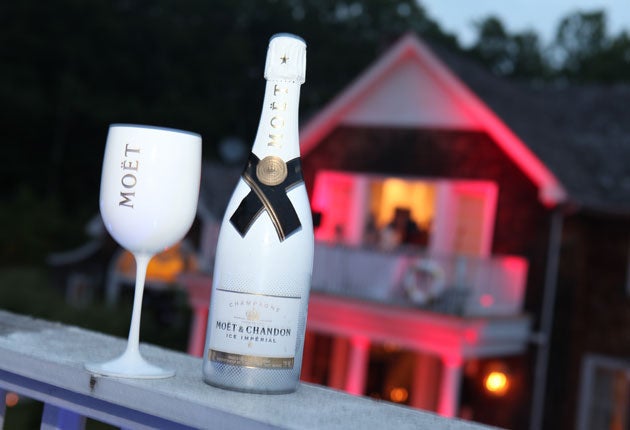Fizz on the rocks: Pimping a classic drink
As difficult economic times continue to take their toll on life's little luxuries, champagne houses have discovered the benefits of pimping the classic drink, reports Luke Blackall

Not so long ago, pouring your champagne into a wine glass and then putting a cube of ice into it would be considered, in polite circles, a fizzy faux-pas.
Now some of the most respected champagne houses are not only saying that it's OK, but they marketing it as the dernier cri – or cru – in imbibing.
While many purists will be spluttering into their flutes at the prospect, Moët & Chandon has decided to create a type of fizz with a bigger body and stronger flavour that is specifically designed to be consumed from a larger glass to allow it to "breathe" and be diluted with ice. It has just released Moët Ice Imperial (£75 a bottle from urban-drinks.co.uk), taking inspiration from the increasing fashion in some bars in and clubs in Paris and the South of France to put an ice cube into their glasses of champagne.
It follows the attempts a few years ago of rival brand Piper-Heidsieck to make the 'Piscine' (drinking champagne over a stack of ice, preferably made from the same champers, frozen, but with ice if budgets didn't quite stretch) the must-have beverage among the beautiful people.
Ice aside, it seems like our thirst for bubbly is unquenchable. In 2010, UK sales were up, as part of a global trend which saw a 9 per cent sales rise. Earlier this year, supermarkets were also reporting rises, with royal wedding celebrations helping Marks and Spencer achieve its best sales of the drink since 2008.
Part of this is, of course, that champagne will always be a symbol of, and a route to, both happiness and hedonism either when the financial aspect is good or when it's gloomy. As Winston Churchill, a big bubbly fan, once said: "In victory, we deserve it. In defeat, we need it." But it is also down to the fact that manufacturers are having to work harder to market their products to consumers. While other luxury products have started to gain solid ground on the BRIC markets (Brazil, Russia, India and China), champagne doesn't have the same foothold in these places as other high-end goods.
Spiros Malandrakis, alcoholic drinks analyst at Euromonitor International, argues that it's the sort of adaptation traditional houses are having to make in tough times. "The recent launch of Ice Impérial retains the focus on luxury but provides a twist on the stale traditionality that historically plagues champagne," he says.
"Inspired by the massive success of rosé wines that capitalised on their ideal character for the summer season, as well as the over-ice trend that revolutionised how people drank cider back in 2005, champagne over ice provides a much-needed innovation for the still-precarious times ahead."
But it's not a trend which satisfies everyone's palette. Alun Griffiths, buying director at wine suppliers Berry Brothers and Rudd, believes it is simply a copycat piece of marketing, which attempts to tap into the same consumer mindset. "It's a bit of a gimmick, for people in bars and in clubs. It's the same as cider over ice, it looks good, like a long drink over ice," he says. "As a purist it takes a huge amount of care and effort to make a great champagne, so if you're making it more condensed then you're interfering with the process."
The introduction of ice cubes and bigger glasses is not the only emerging trend, though. Galoupet restaurant, which opened last week in London, is home to what it claims is the capital's first 'enomatic' champagne machine, which gives customers the chance to try some vintage, normally only available by the (very expensive) bottle, by the glass. But with a glass of Krug Grand Cuvée Brut costing £35 and Dom Perignon Oenotheque 1996 costing £50 a glass, it remains a luxury.
Pol Roger has found success with the introduction of PURE (from around £36 per bottle), which is a low calorie champagne with no added sugar. Similarly, Laurent-Perrier has just launched its Ultra Brut (from around £45.99 per bottle), a super-dry champagne with no added sugar.
Meanwhile, Searcy's new Champagne Bar in One New Change near St Paul's, has introduced another trend that's popular on the continent - champagne decanting. Used mainly for older, bigger bodied vintages, it is designed to open up the drink's flavours. But being in a decanter also adds both a ritual and theatrical element to the drink. Important, as a number of those having their champagne decanted are business customers trying to impress clients.
If these innovations fail to impress the fizz fans among you, fear not. With the economic outlook as yet still a far from certain, it looks likely that producers will continue to pull out all the stops – as well as the corks – in a bid to try to get us to open our wallets, as well as our mouths.
Subscribe to Independent Premium to bookmark this article
Want to bookmark your favourite articles and stories to read or reference later? Start your Independent Premium subscription today.

Join our commenting forum
Join thought-provoking conversations, follow other Independent readers and see their replies